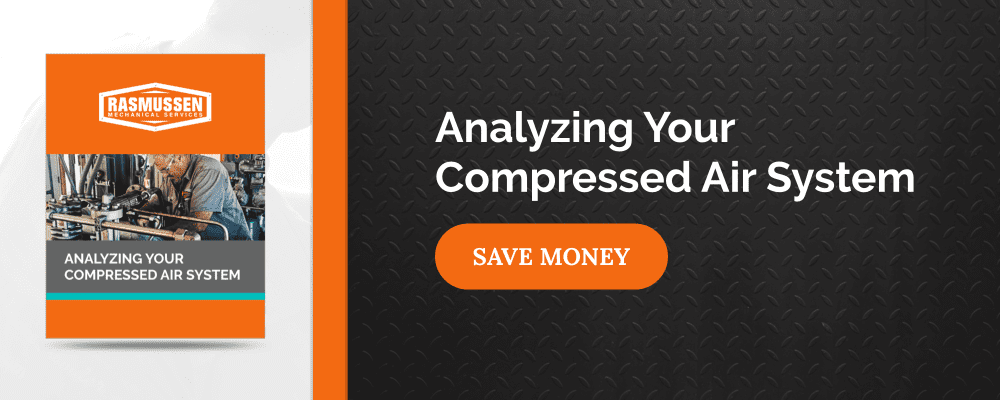Moisture is in the air. Whether you notice them or not, tiny droplets find their way across your facility and end up in your commercial air compressors. This moisture must be removed for air to be dry enough for the system to work properly. An efficient air system doesn’t just happen. It’s a product of good planning and maintenance. An inefficient system results in higher costs per unit of compressed air, improper or erratic tool operation, shortened component life, reduced capacity and the formation of rust and sludge in the main and branch lines. Significant compressed air (and energy) losses can occur if condensate removal is done improperly.
Removing Condensate From Your Air System
Did you know? On a typical summer day of 80℉ (21℃) and 70% relative humidity, approximately 19.5 gallons (73.8 liters) of water enters a 100 scfm (170 nm3/hr) system in a 24 hour period.
Condensate shortens the life of compressed air-operated machinery and can contaminate products – causing significant maintenance costs and loss of productivity. To determine appropriate air quality requirements, the end-use equipment must be analyzed. Many variables must be considered when deciding on the level of air quality to produce. Particulate, moisture and lubricant tolerance levels are just a few of the factors to consider. Once you know the quality of air required by your facility, you can start implementing the right strategies and selecting the right equipment.
Pro Tip: Learn more about ISO air quality standards.
Moisture build up in condensate traps creates an ideal environment for bacteria growth. Learn more: Click To TweetOnce you know the quality of air required by your facility, then you can start implementing the right strategies and selecting the right equipment. The first step is to look at your condensate traps. Moisture enters the compressed air system through the compressor’s fresh air intake. This moisture creates an ideal environment for bacterial growth inside your compressed air piping and will wreak havoc on end-use machinery, not to mention contamination of food-grade products.
Drain the Compressor Tanks
For a compressor that delivers 20 liters of air per second, it also supplies 24 liters of water a day.
The first stage of keeping moisture out of your lines is to drain the air compressor tank frequently. This should be done every time you use your air compressor to prevent rust building up on the inside of your tank and to keep moisture out. This moisture creates an ideal environment for bacterial growth inside your compressed air piping and will wreak havoc on end-use machinery, not to mention contamination of food-grade products. The most effective way to eliminate the demand side open drainage is to install dryers and filters at the air compressors.
[Want to reduce the amount of air and energy losses from your compressed air system? Download our checklist, Analyzing Your Compressed Air System, to reduce your energy losses.]
Removal Method
Air must not contain liquid moisture and should be at a relative humidity of less than 50% to prevent corrosion.
To increase efficiency and maintain air quality for end-use equipment, condensate must be removed from the compressed air. There are many effective ways to do this. It is important to be cognizant of the removal method because each has its own levels of potential compressed air loss. The U.S. Department of Energy Efficiency and Renewable Energy created a simple chart to help you determine the appropriate means of draining condensate:


Source: U.S. Department of Energy – Energy Efficiency and Renewable Energy, Compressed Air Tip Sheet #13 • August 2004
Following Actions:
- Inspect the condensate traps and determine if they are operating properly.
- Review your condensate removal method, and if possible, the load on compressors during non-production hours. If it releases too much air, consider upgrading to zero-loss drain traps.
Moisture Removal Techniques
Using compressed air dryers is a common method for removing moisture. There are 5 techniques for removing moisture from compressed air: (Source: The Compressed Air Blog)
- Cooling plus separation is exactly how it sounds. The hot compressed air is cooled, which allows a large amount of water to condense. Once the water is condensed, it can then be separated from the air.
- Over-compression involves the compression of air to a higher pressure than the intended working pressure. After separation, the air is allowed to expand to the working pressure so it can be used in the intended process.
- Membrane drying uses the process of selective permeation of the gas components in the air to separate the water vapor out of your air system.
- Absorption drying is a chemical process in which water vapor is bound to an absorption material such as sodium chloride or sulfuric acid.
- Adsorption drying involves the flow of moist air over a hygroscopic material or “desiccant” to be dried. Typical materials used are silica gel, molecular sieves, and activated alumina.
Maintain High Air Quality
Did you know the generation of compressed air can account for up to 40% of a plant’s total electrical bill?
Sustaining proper air quality levels can be a balancing act. While low air quality levels result in inefficiencies in compressed air use, it is easy to spend too many resources on maintaining high air quality levels that exceed plant requirements. Facility upkeep directly results in money saved, stress averted and problems solved. Our quality trained professionals can help you remove condensate from your Compressed Air System and maximize your plant efficiencies.
Hire the experts in preventative maintenance and ensure your company’s success. It is important for any company to keep operations as cost-effective as possible. Spending the money on the front end can prevent further and more costly expenses down the road. Create a structured system designed to inspect all of these components regularly.
Rasmussen Mechanical Services will perform comprehensive surveys on your compressed air, vacuum or blower systems to help identify what products and services will work best for you. We’re dedicated to meeting your needs with unparalleled expertise, design, and service.
Rasmussen Mechanical Services is a family business through and through. We’re focused on building relationships with our clients and employees, bringing both the goals and solutions they need and want. We are dedicated to obtaining the latest research, training, certification, and equipment so we can confidently provide the best in class service. We partner with experienced industry leaders and prioritize being up-to-date on emerging technology. Part of our approach in taking care of our clients lies in our belief in top-quality preventative maintenance. If you’re not sure where to start, or you’d like help creating a strategy, contact us today!




